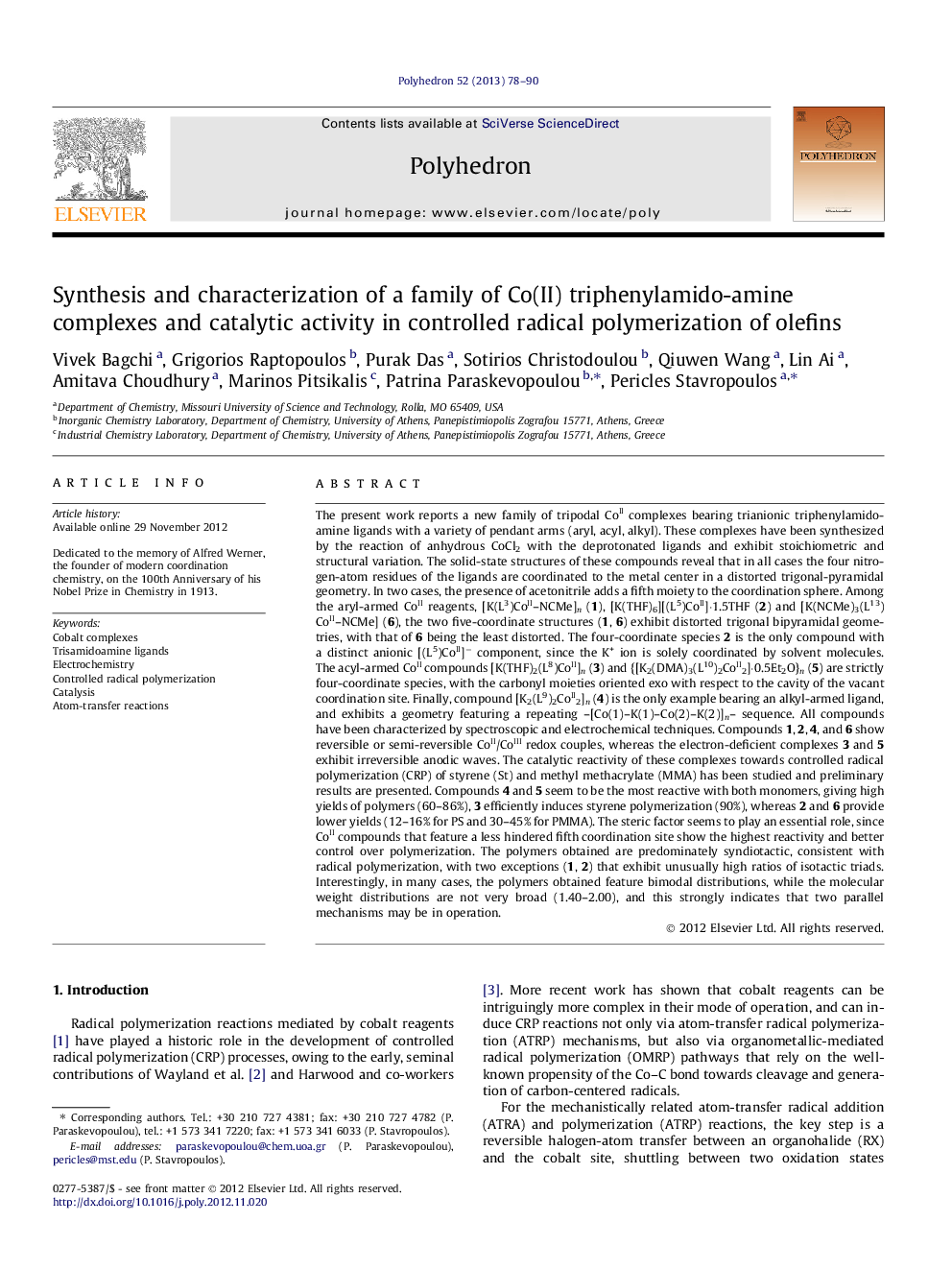| کد مقاله | کد نشریه | سال انتشار | مقاله انگلیسی | نسخه تمام متن |
|---|---|---|---|---|
| 1336923 | 1500287 | 2013 | 13 صفحه PDF | دانلود رایگان |

The present work reports a new family of tripodal CoII complexes bearing trianionic triphenylamido-amine ligands with a variety of pendant arms (aryl, acyl, alkyl). These complexes have been synthesized by the reaction of anhydrous CoCl2 with the deprotonated ligands and exhibit stoichiometric and structural variation. The solid-state structures of these compounds reveal that in all cases the four nitrogen-atom residues of the ligands are coordinated to the metal center in a distorted trigonal-pyramidal geometry. In two cases, the presence of acetonitrile adds a fifth moiety to the coordination sphere. Among the aryl-armed CoII reagents, [K(L3)CoII–NCMe]n (1), [K(THF)6][(L5)CoII]·1.5THF (2) and [K(NCMe)3(L13)CoII–NCMe] (6), the two five-coordinate structures (1, 6) exhibit distorted trigonal bipyramidal geometries, with that of 6 being the least distorted. The four-coordinate species 2 is the only compound with a distinct anionic [(L5)CoII]− component, since the K+ ion is solely coordinated by solvent molecules. The acyl-armed CoII compounds [K(THF)2(L8)CoII]n (3) and {[K2(DMA)3(L10)2CoII2]·0.5Et2O}n (5) are strictly four-coordinate species, with the carbonyl moieties oriented exo with respect to the cavity of the vacant coordination site. Finally, compound [K2(L9)2CoII2]n (4) is the only example bearing an alkyl-armed ligand, and exhibits a geometry featuring a repeating –[Co(1)–K(1)–Co(2)–K(2)]n– sequence. All compounds have been characterized by spectroscopic and electrochemical techniques. Compounds 1, 2, 4, and 6 show reversible or semi-reversible CoII/CoIII redox couples, whereas the electron-deficient complexes 3 and 5 exhibit irreversible anodic waves. The catalytic reactivity of these complexes towards controlled radical polymerization (CRP) of styrene (St) and methyl methacrylate (MMA) has been studied and preliminary results are presented. Compounds 4 and 5 seem to be the most reactive with both monomers, giving high yields of polymers (60–86%), 3 efficiently induces styrene polymerization (90%), whereas 2 and 6 provide lower yields (12–16% for PS and 30–45% for PMMA). The steric factor seems to play an essential role, since CoII compounds that feature a less hindered fifth coordination site show the highest reactivity and better control over polymerization. The polymers obtained are predominately syndiotactic, consistent with radical polymerization, with two exceptions (1, 2) that exhibit unusually high ratios of isotactic triads. Interestingly, in many cases, the polymers obtained feature bimodal distributions, while the molecular weight distributions are not very broad (1.40–2.00), and this strongly indicates that two parallel mechanisms may be in operation.
A new family of tripodal CoII complexes bearing trianionic triphenylamido-amine ligands with a variety of pendant arms (aryl, acyl, alkyl) has been synthesized and characterized by various physicochemical methods. Their solid-state structures reveal that a minimal coordination sphere composed of four ligand-derived nitrogen-atom residues is always present, and is occasionally augmented by the coordination of an acetonitrile molecule. Their catalytic activity in controlled radical polymerization (CRP) of styrene and methyl methacrylate is also discussed.Figure optionsDownload as PowerPoint slideHighlights
► CoII compounds bearing triphenylamido-amine ligands have been synthesized.
► X-ray structural analysis reveals five- or four-coordinate species.
► Electrochemical data for all CoII compounds is being reported.
► The CoII complexes induce controlled radical polymerization (CRP) reactions.
Journal: Polyhedron - Volume 52, 22 March 2013, Pages 78–90